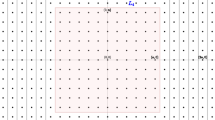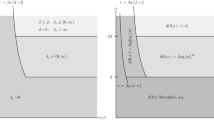Abstract
A model of directed percolation processes with colors and flavors that is equivalent to a population model with many species near their extinction thresholds is presented. We use renormalized field theory and demonstrate that all renormalizations needed for the calculation of the universal scaling behavior near the multicritical point can be gained from the one-species Gribov process (Reggeon field theory). In addition this universal model shows an instability that generically leads to a total asymmetry between each pair of species of a cooperative society, and finally to unidirectionality of the interspecies couplings. It is shown that in general the universal multicritical properties of unidirectionally coupled directed percolation processes with linear coupling can also be described by the model. Consequently the crossover exponent describing the scaling of the linear coupling parameters is given by Φ=1 to all orders of the perturbation expansion. As an example of unidirectionally coupled directed percolation, we discuss the population dynamics of the tournaments of three species with colors of equal flavor.
Similar content being viewed by others
REFERENCES
H. K. Janssen, Z. Phys. B: Cond. Mat. 42:151 (1981).
P. Grassberger, Z. Phys. B: Cond. Mat. 47:365 (1982).
S. R. Broadbent and J. M. Hammersley, Proc. Camb. Philos. Soc. 53:629 (1957).
J. L. Cardy and R. L. Sugar, J. Phys. A: Math. Gen. 13:L423 (1980).
S. P. Obukhov, Physica A 101:145 (1980).
V. N. Gribov, Sov. Phys. JETP 26:414 (1968); V. N. Gribov and A. A. Migdal, Sov. Phys. JETP 28:784 (1969).
M. Moshe, Phys. Rep. C 37:255 (1978).
P. Grassberger and K. Sundermeyer, Phys. Lett. B 77:220 (1978); P. Grassberger and A. de La Torre, Ann. Phys. (New York), 373 (1979).
T. E. Harris, Ann. Prob. 2:969 (1974).
T. M. Liggett, Interacting Particle Systems (Springer, Berlin, 1985).
I. Jensen and R. Dickman, Physica A 203:175 (1994).
W. Kinzel, in Percolation Structures and Processes, G. Deutsch, R. Zallen, and J. Adler, eds. (Hilger, Bristol, 1983); Z. Phys. B: Cond. Mat. 58:229 (1985).
R. M. Ziff, E. Gulari, and Y. Barshad, Phys. Rev. Lett. 56:2553 (1986).
G. Grinstein, Z.-W. Lai, and D. A. Browne, Phys. Rev. A 40:4820 (1989).
H. Hinrichsen, cond-mat/0001070.
P. Grassberger, Directed percolation: results and open problems, preprint WUB 96-2 (1996), unpublished.
H. Hinrichsen, cond-mat/9910284.
H. K. Janssen, Ü. Kutbay, and K. Oerding, J. Phys. A: Math. Gen. 32:1809 (1999).
H. K. Janssen, Phys. Rev. E 55:6253 (1997).
F. Schlögl, Z. Phys. 225:147 (1972).
M. Doi, J. Phys. A: Math. Gen. 9:1479 (1976); P. Grassberger and P. Scheunert, Fortschr. Phys. 28:547 (1980).
L. Peliti, J. Phys. (France) 46:1469 (1984); B. P. Lee, J. Phys. A: Math. Gen. 27:2633 (1994).
H. K. Janssen, Z. Phys. B: Cond. Mat. 58:311 (1985).
M. J. Howard and U. C. Täuber, J. Phys. A: Math. Gen. 30:7721 (1997).
J. L. Cardy and U. C. Täuber, Phys. Rev. Lett. 77:4783 (1996); J. Stat. Phys. 90:1 (1998).
J. Hofbauer and K. Sigmund, The Theory of Evolution and Dynamical Systems (Cambridge University Press, 1988).
J. D. Murray, Mathematical Biology (Springer, Berlin, 1988).
U. Alon, M. R. Evans, H. Hinrichsen, and D. Mukamel, Phys. Rev. Lett. 76:2746 (1996); Phys. Rev. E 57:4997 (1998).
H. K. Janssen, Phys. Rev. Lett. 78:2890 (1997).
U. C. Täuber, M. J. Howard, and H. Hinrichsen, Phys. Rev. Lett. 80:2165 (1998); Y. Y. Goldschmidt, Phys. Rev. Lett. 81:2178 (1998); Y. Y. Goldschmidt, M. J. Howard, H. Hinrichsen, and U. C. Täuber, Phys. Rev. E 59:6381 (1999).
T. Ohtsuki and T. Keyes, Phys. Rev. A 35:2697 (1987), Phys. Rev. A 36:4434 (1987).
D. J. Amit, Field Theory, the Renormalization Group and Critical Phenomena (World Scientific, Singapore, 1984).
J. Zinn-Justin, Quantum Field Theory and Critical Phenomena, 2nd revised edition (Clarendon, Oxford, 1993).
R. Bausch, H. K. Janssen, and H. Wagner, Z. Phys. B: Cond. Mat. 24:113 (1976).
C. De Dominicis and L. Peliti, Phys. Rev. B 18:353 (1978).
H. K. Janssen, in Dynamical Critical Phenomena and Related Topics, Lecture Notes in Physics, Vol. 104, C. P. Enz, ed. (Springer, Heidelberg, 1979).
C. De Dominicis, J. Phys. (France) Colloq. 37:C247 (1976).
H. K. Janssen, Z. Phys. B: Cond. Mat. 23:377 (1976).
H. K. Janssen, in From Phase Transitions to Chaos, G. Györgyi, I. Kondor, L. Sasvári, and T. Tél, eds. (World Scientific, Singapore, 1992).
K. Kawasaki, in Proc. Varenna Summer School on Critical Phenomena, M. S. Green, ed. (Academic, New York, 1971); in Phase Transitions and Critical Phenomena, Vol. 5a, C. Domb and M. S. Green, eds. (Academic, London, 1976).
P. C. Martin, E. D. Siggia, and H. H. Rose, Phys. Rev. A 8:423 (1973).
M. Baker, Phys. Lett. B 51:158 (1974).
J. B. Bronzan and J. W. Dash, Phys. Lett. B 51:496 (1974), Phys. Rev. D 10:4208 (1974), Phys. Rev. D 12:1850 (1974).
F. J. Wegner, J. Phys. C 7:2098 (1974), in Phase Transitions and Critical Phenomena, Vol. 6, C. Domb and M. S. Green, eds. (Academic, New York, 1976).
H. K. Janssen, Z. Phys. B: Cond. Mat. 97:239 (1995).
F. Harary, Graph Theory (Addison-Wesley, 1969).
R. M. May and W. J. Leonard, SIAM J. Appl. Math. 29:243 (1979).
J. Coste, J. Peyraud, and P. Coullet, SIAM J. Appl. Math. 36:516 (1979).
P. Schuster, K. Sigmund, and R. Wolff, SIAM J. Appl. Math. 37:49 (1979).
J. Hofbauer and J. W.-H. So, SIAM Appl. Math. Lett. 7:65 (1994).
S. Cornell, M. Droz, R. Dickman, and M. C. Marques, J. Phys. A: Math. Gen. 24:5605 (1991).
K. E. Bassler and D. A. Brown, Phys. Rev. Lett. 77:4094 (1996).
Author information
Authors and Affiliations
Rights and permissions
About this article
Cite this article
Janssen, HK. Directed Percolation with Colors and Flavors. Journal of Statistical Physics 103, 801–839 (2001). https://doi.org/10.1023/A:1010300703724
Issue Date:
DOI: https://doi.org/10.1023/A:1010300703724




